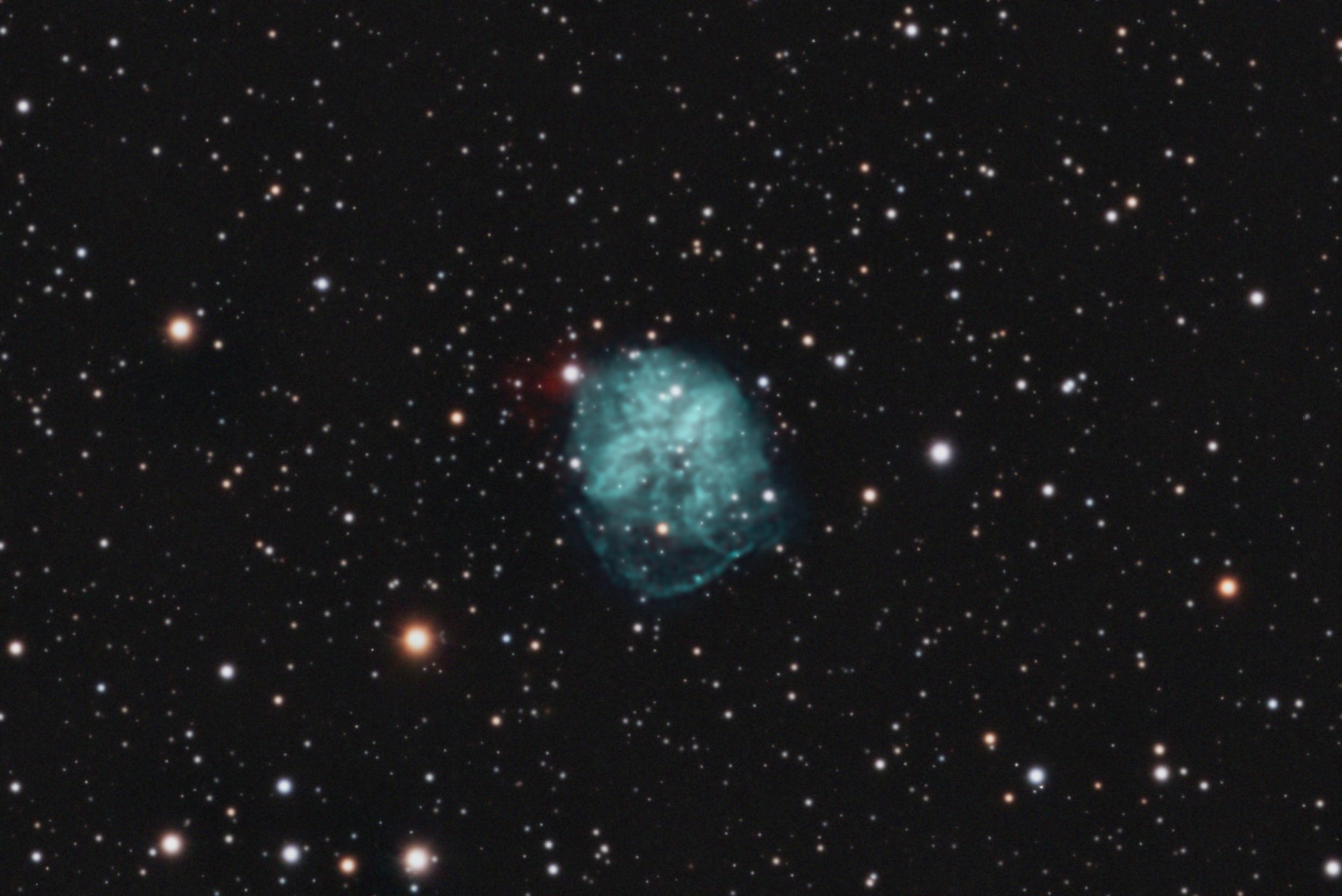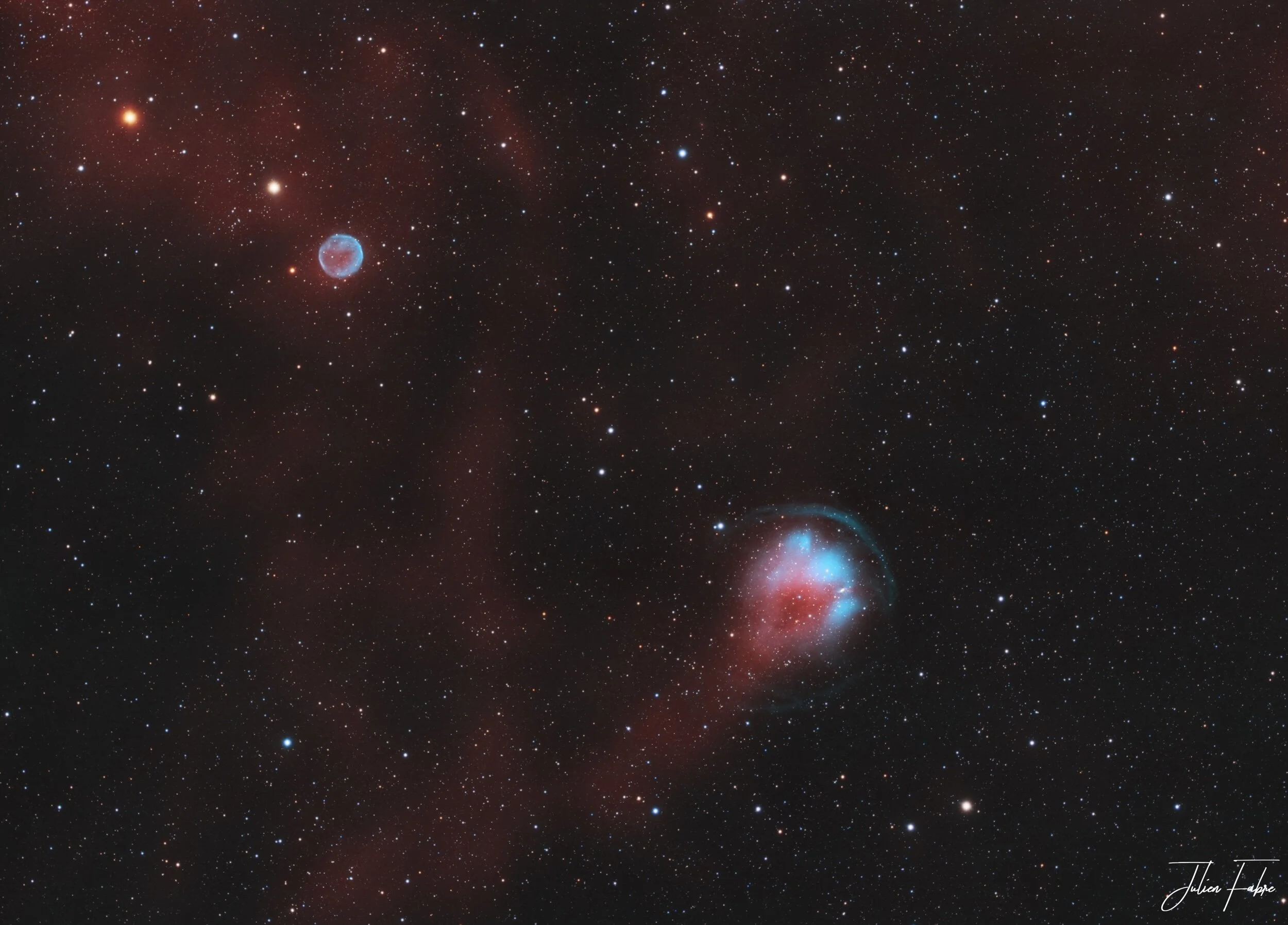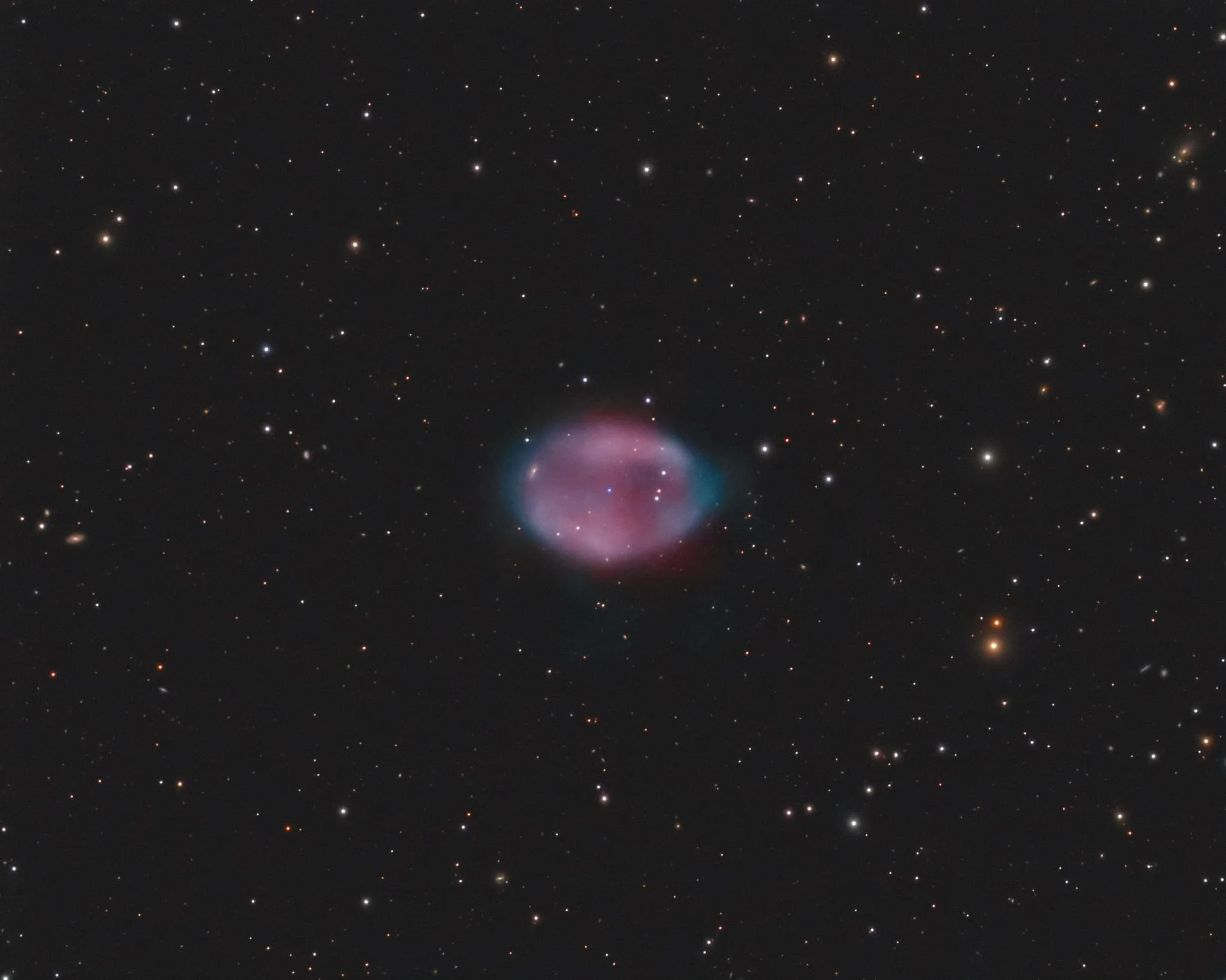
AAPOD2 Image Archives
K2-1
Image Description and Details :
K2-1
A very faint and obscure planetary nebula some 3700 light years away in the constellation Auriga.
Initially catalogued as a planetary nebula, was later thought to be misclassified and considered to be either a reflection nebula (LBN 809), an H-II region, and even a galaxy (PGC 16765). However it has recently been rediscovered as a genuine planetary nebula. It has a size of 115x126 arc seconds and is predominantly OIII. The weaker Ha signal has a similar form to the OIII signal. However there's an odd small area of red nebulosity at the top left-hand corner. This is possibly some NII emission which would be captured by the 5nm bandwith of my Ha filter (the spectrum shows that NII is present).
Discovered by Czech astronomer Dr. Luboš Kohoutek in 1962 by visually examining the National Geographic Society-Palomar Observatory Sky Survey prints at the Astronomical Institute in Prague, Czech Republic
It has a mean surface brightness of 24.1 mag/arc sec.
Image captured on my remote dual rig at Fregenal de la Sierra in Spain between 19-23 February 2022.
Scopes: APM TMB LZOS 152 Refractors
Cameras: QSI6120wsg8
Mount: 10Micron GM2000 HPS
A total of 37 hours image capture (HaOIIIRGB)
Copyright: Peter Goodhew
Ferrero 6 (Fe 6) Planetary Nebula
Image Description and Details : I have been capturing Ferrero 6 for two months on my second rig. Typically here in Michigan USA, the autumn has the most amount of clear nights out of the year. Subsequently I planned on a deep space object that was very faint and challenging. Unfortunately this autumn was not typical at all with a major amount of cloudy nights and precipitation, like the rest of this past year here. Even with the amount of integration time I piled on, I really had to massage the data pretty hard. Very few have attempted to capture it, so I thought I would give it a try.
Ferrero 6 (Ferrero 6 • Fe6 • PN G129.6+03.4) Planetary Nebula was discovered as part of the IPHAS survey. It's spectroscopically was confirmed as a true planetary nebula by the professional astronomer Laurence Sabin in September 2011. It has also been independently discovered by the French amateur astronomer Laurent Ferrero in 2013. Its structure consists of a low surface brightness bubble with a size of 3.5 arcminutes, which is accentuated by a thin bright rim on the outside. It is very likely to be an ancient evolved planetary nebula that is interacting with the interstellar medium.
Copyright: Copyright: Douglas J Struble
HFG1/ Abell 6
Image Description and Details :Heckathorn-Fesen-Gull 1 (HFG1) and Abell 6 are a duo of planetary nebulae from the constellation Cassiopea.
The central star of HFG1 is a 14.5 mag binary star. It leaves behind a gas tail of at least 20 '. She is said to be around 10,000 years old.
The structure of HFG1 presents an arc of a circle opposite the tail, in the direction of movement of the nebula, which suggests that it is a shock wave front of matter interacting with the interstellar medium.
Abell 6 is an example of a bubble-shaped planetary nebula. However, it remains quite faint (Mag = 15). It emits more in OIII than in Ha.
TSA120 and asi294MM
220x 300s Ha
220x 200s OIII
90x 120s RGB ( for stars)
Total around 40h
Copyright: Julien Fabre
PM1-320
PM1-320 is a small planetary nebula in Cygnus, close to DWB 111, the Propeller Nebula.
It was discovered by Andrea Preite-Martinez in the 1980s.
I believe this to be the first deep high-resolution image of PM1-320.
The outer parts of the nebulosity are very faint, hence 56 hours of OIII integration.
HASH records it's size as 60 arc seconds.
TARGET
Nomenclature: PM1-320
Right Ascension: 20:10:33.6
Declination: +44:11:48.48
Size: 60.0 arc sec
Discovery: Andrea Preite-Martinez
EQUIPMENT USED
Twin APM TMB LZOS 152 refractors
10Micron GM2000 HPS mount
Twin QSI6120 CCD cameras
Astrodon filters
IMAGE CAPTURE
Blue: 10x300"
Green: 10x300"
Lum: 15x300"
Red: 10x300"
Ha: 103x900" bin 1x1
OIII: 226x900 bn 1x1
Total Integration: 86 hours
Pixel scale: 0.265 arcsec/pixel
Field radius: 0.368 degrees
Capture dates: 20 August-3 September 2021
Capture location: Fregenal de la Sierra, Spain
IMAGE PROCESSING
Pre-processing: CCDStack2
Post-processing: Photoshop CS2
Copyright: Peter Goodhew
PN G136.7+61.9
PN G136.7+61.9 is a planetary nebula in Ursa Major.
PN G136.7+61.9 is extremely faint planetary nebula with size of about 7 arcminute that was discovered in 2013 by analysing data from the SDSS spectroscopic survey. The Sloan Digital Sky Survey or SDSS is a major multi-spectral imaging and spectroscopic redshift survey using a dedicated 2.5m wide-angle optical telescope at Apache Point Observatory in New Mexico, United States. The project was named after the Alfred P. Sloan Foundation, which contributed significant funding.
This is the first colour image ever taken of PN G136.7+61.9 planetary nebula. In appearance, as well as low surface brightness, this planetary nebula could be called "Night Owl Nebula".
This image taken over several nights in May 2021.
L-channel - 52 x 150 sec. bin 1x1;
R-channel - 24 x 150 sec. bin 1x1;
G-channel - 24 x 150 sec. bin 1x1;
B-channel - 24 x 150 sec. bin 1x1;
Ha- 59 x 900 sec. bin 2x2;
OIII- 50 x 900 sec. bin 2x2.
Total integration time about 32:25 hours.
My setup: Telescope 8" Celestron Schmidt-Cassegrain (SCT) CPC800 GPS (XLT) on the equatorial wedge, focal reducer Starizona Night Owl 0.4х, Feq=864mm, camera Starlight Xpress Trius SX694, SX mini filter wheel, filters Astrodon LRGB E-series gen.2, Astrodon Ha 5nm, Astrodon OIII 3nm.
Capture and processing software: MaxIm DL6, PHD2, PixInsight, StarTools, Photoshop CC, Zoner photo studio 14.
North at the top.
Copyright: Boris Vladimirovich
NGC 6543 Cat's Eye Nebula
Image Description and Details :
The Cat Eye Nebula, NGC 6543, is a mythical object from the deep sky of the Northern Hemisphere.
It is a Planetary Nebula (expanding gas shell ejected from an end-of-life star) in the constellation of the Dragon, whose age is estimated at only 1,000 years and the distance at "only" 5,200 light years . (our galaxy has a span of 100,000 light years).
The star in the white dwarf stage is clearly visible in the center of the nebula, the central part of which has a diameter of only 20 arc seconds, which is tiny, one of the reasons why it is relatively little imagined.
The sampling used here made it possible to resolve this core of the nebula by spreading it over approximately 40 pixels of the image and thus to distinguish some details there, which was made possible by the use of one of the telescope Ritchey Chretien 500mm f / 8 from the Astroqueyras observatory in the Hautes Alpes with a focal length of 4000mm.
The outer halo of the nebula, ejected by the star when it was in the red giant stage, extends for its part over nearly 6 minutes of arc, but is much more tenuous than the central part.
It was therefore necessary to mix short exposures on the heart and long exposures on the external halo and the rest of the image and then perform HDR processing.
The galaxy of the "barred spiral" type NGC 6552 visible to the right of the cat's eye also shows us some pretty details despite its dizzying distance of around 360 million light years!
For acquisition data:
- 10 exposures of 1mn in Luminance bin 1 on the heart
- 28 exposures of 2mn in Luminance bin2 on the rest
- 15 poses of 1mn in R, G and B bin1 on the heart
- 12 poses of 2mn in R, G and B bin2 on the rest
A total of only 3 hours of exposure to acquire all of this data at the Pic de Chateau Renard observatory, Alps, France with an RC 500 f / 8 telescope on an AP1600 mount + Apogee 16000 camera
Scale 0.5"
Seeing 1.5"
Bortle 1
1.5<FWHM<1.7
Pixinsight and Photoshop 2020 processing (never managed before to obtain a version which satisfies me).
Copyright Information: Mathieu Guinot
Hartl-Dengel-Weinberger 3 (HDW 3)
Hartl-Dengel-Weinberger 3 (HDW 3) is an extremely faint ancient planetary nebula in the constellation Perseus. It is so faint that it is very rarely imaged.
The progenitor star is the small blue star at the 5 o-clock position just below the large yellow star in HDW 3. The progenitor is not, as one would expect, in the centre of the nebula. This is because it is moving rapidly in a north-westerly direction. It is moving through a dense area of interstellar medium (ISM). This ISM is slowing down HDW 3, creating a shock front and the unusual "braided" appearance. As the star isn't slowed by the ISM it has continued to move and is thus no longer at the centre of HDW 3 and is slowly overtaking HDW 3. This causes the shock front to be brighter as it's getting more ultraviolet radiation, whereas the opposite side of HDW 3 is getting less UV radiation and has become invisible. This movement of the star causes differential excitation of the shell. OIII emission, which requires higher energy of the ionizing radiation than HII emission, only happens close to the star.
EQUIPMENT USED
Twin APM TMB LZOS 152 refractors
10Micron GM2000 HPS mount
Twin QSI6120 CCD cameras
Astrodon filters
IMAGE CAPTURE
5nm H-Alpha: 76x1800 bin 2x2
3nm OIII: 51x1800 bin 2x2
Luminance: 39x300 bin 1x1
Red: 20x300 bin 1x1
Green: 20x300 bin 1x1
Blue: 17x300 bin 1x1
Total integration: 71.5 hours
Pixel scale: 0.534 arcsec/pixel
Field radius: 0.359 degrees
Capture dates: 15 November - 8 December 2019
Capture location: Fregenal de la Sierra, Spain
Copyright: Peter Goodhew







